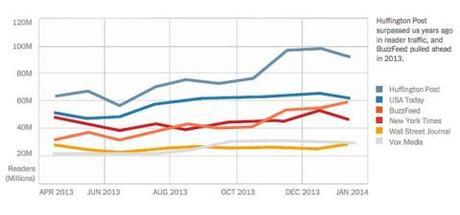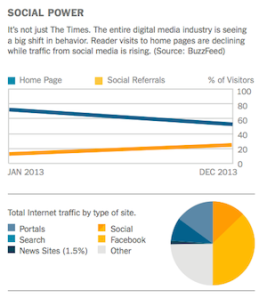 The Gray Lady has problems – more than just the firing of Jill Abramson or lack of reporting on Jill Abramson’s demise. It seems the Times is behind the times in all things digital. On May 15, Buzz Feed leaked the 96-page New York Times Innovation Report that candidly describes the digital struggles and weaknesses of the legendary print icon. The report focuses on digital providers like Vox, Huffington Post, Business Insider, and BuzzFeed. The report describes the institutional inertia that is keeping many businesses from embracing the new face of marketing. And in some terrible irony of ironies, it was that upstart BuzzFeed that leaked the story.
The Gray Lady has problems – more than just the firing of Jill Abramson or lack of reporting on Jill Abramson’s demise. It seems the Times is behind the times in all things digital. On May 15, Buzz Feed leaked the 96-page New York Times Innovation Report that candidly describes the digital struggles and weaknesses of the legendary print icon. The report focuses on digital providers like Vox, Huffington Post, Business Insider, and BuzzFeed. The report describes the institutional inertia that is keeping many businesses from embracing the new face of marketing. And in some terrible irony of ironies, it was that upstart BuzzFeed that leaked the story.
Key learnings for all marketers today.
1. Beware of Disrupters. The news biz is changing like all business today. Once small outsiders like BuzzFeed and Huffington Post are now garnering more traffic than the Times. Sound familiar? Like Amazon, AirBnB, Uber and other disrupters? The report gives some of the hallmarks of disruptive innovators – introduced by an outsider, less expensive than existing products, targeting new or underserved markets, initially inferior to existing products and advanced by an enabling technology. Sound familiar in your business category? Your competition may not be who it was yesterday. Today the New York Times is facing disparate competition such as LinkedIn’s Pulse Publishing platform, Flipboard’s visual presentation of news, Vox as a collector of live blogging in passionate verticals, or Yahoo News that has hired Katie Couric and repurposes the best of news.

2. Stories Find Readers Today. The Times identified a trend showing that users are moving away from browsing and actually expect the news to come to them through social media, mobile notifications, aggregators and more.
Janine Gibson, editor-in-chief of The Guardian’s website says, “The realization that you have to go find your audience — they’re not going to just come and read it — has been transformative.”
Death of the Home Page. Only a third of readers visit the home page of The New York Times. And those who do visit are spending less time on it. Page views and minutes spent per reader dropped by double-digit percentages in the year 2013. Where do people see your content? We cannot expect our website to be the first view of information.
 News from Social Media. Less than 10% of the New York Times traffic comes from social media compared to Buzzfeed who gets 60% of their traffic from social media. In fact, I read the story about the New York Times report on LinkedIn and Mashable first.
News from Social Media. Less than 10% of the New York Times traffic comes from social media compared to Buzzfeed who gets 60% of their traffic from social media. In fact, I read the story about the New York Times report on LinkedIn and Mashable first.
Marketers cannot expect just one media to work for them. It takes multiple ways to get your important news out. Social media, email marketing, guest posts, podcasts, interviews, speaking engagements, search marketing and even advertising, if well timed and placed.
3. Content Packaging is as Important as the Story. Journalists have thought that the story is the thing. Build it and they will come. But today, a journalist must craft the right story for the audience, understanding the reader relevance. I was stunned by a story from Forbes writer Kashmir Hill who took an anecdote buried in a 5,000 word article in the times and repackaged it as “How Target Figured Out A Teen Girl Was Pregnant Before Her Father Did.” Her Forbes article has been viewed 2,455,821 times, and was the chief traffic driver for the Times story. Crafting the right point of view takes a real understanding of your target audience. And then, you have to position your story appropriately, with engaging content.
4. Timing is Everything. The Times is publishing their best content on a schedule meant for print. They publish the majority of their content in the late evening, in order for it to make the morning paper, while the majority of their traffic is in the morning hours. The biggest stories are published on Sundays for the venerable Sunday Paper, even though Sunday is the slowest day for traffic online. A lesson to marketers here is are you publishing at times when you audience will see them? In today’s world, the news is a 24-hour operation and news consumers expect to have it on a 24-hour schedule.
5. Every Story Needs A Promotional Strategy. All content needs a promotion strategy. The publishing of the story is just the beginning. What is the social strategy? Is there a checklist for publishing that includes search headline, tags, images, pre-written Facebook and Twitter posts?
“Even ProPublica, that bastion of old-school journalism values, goes to extraordinary lengths to give stories a boost. An editor meets with search, social and public relations specialists to develop a promotion strategy for every story. And reporters must submit five tweets along with each story they file.”
How can you repurpose the content? The Times report tells, “On a whim, Andrew Phelps created a Flipboard magazine of our most important obits of the year and it became the best-read collection in the history of the platform.” The Gawker took a 161 year old story from The Times to help introduce “12 Years as a Slave”.
Consumers Expect Personalization. The Times is looking at new engines to foster personalization online. Increasingly, consumers are expecting to have options served up to them based on preferences. Can readers follow their favorite columnists?
Engagement is everyone’s job. A key learning is that you need to engage with your audience – respond to comments, answer emails and converse on social media. Equally important is looking at the list of influencers that can help spread your message and interact with them. Or events that help create community.
6. Silos are out, teams are in. Here is the telling statement: “Our Twitter account is run by the newsroom. Our Facebook account is run by the business side.” Departments need to break down walls and work together. The refiguring of team is important to create more harmonious efforts. The Times has recognized the power of collaboration focused on reader experience. What a wonderful concept!
The first step toward change is awareness. The second step is acceptance. So, as The Times goes, it seems they are embarking upon an important journey.

